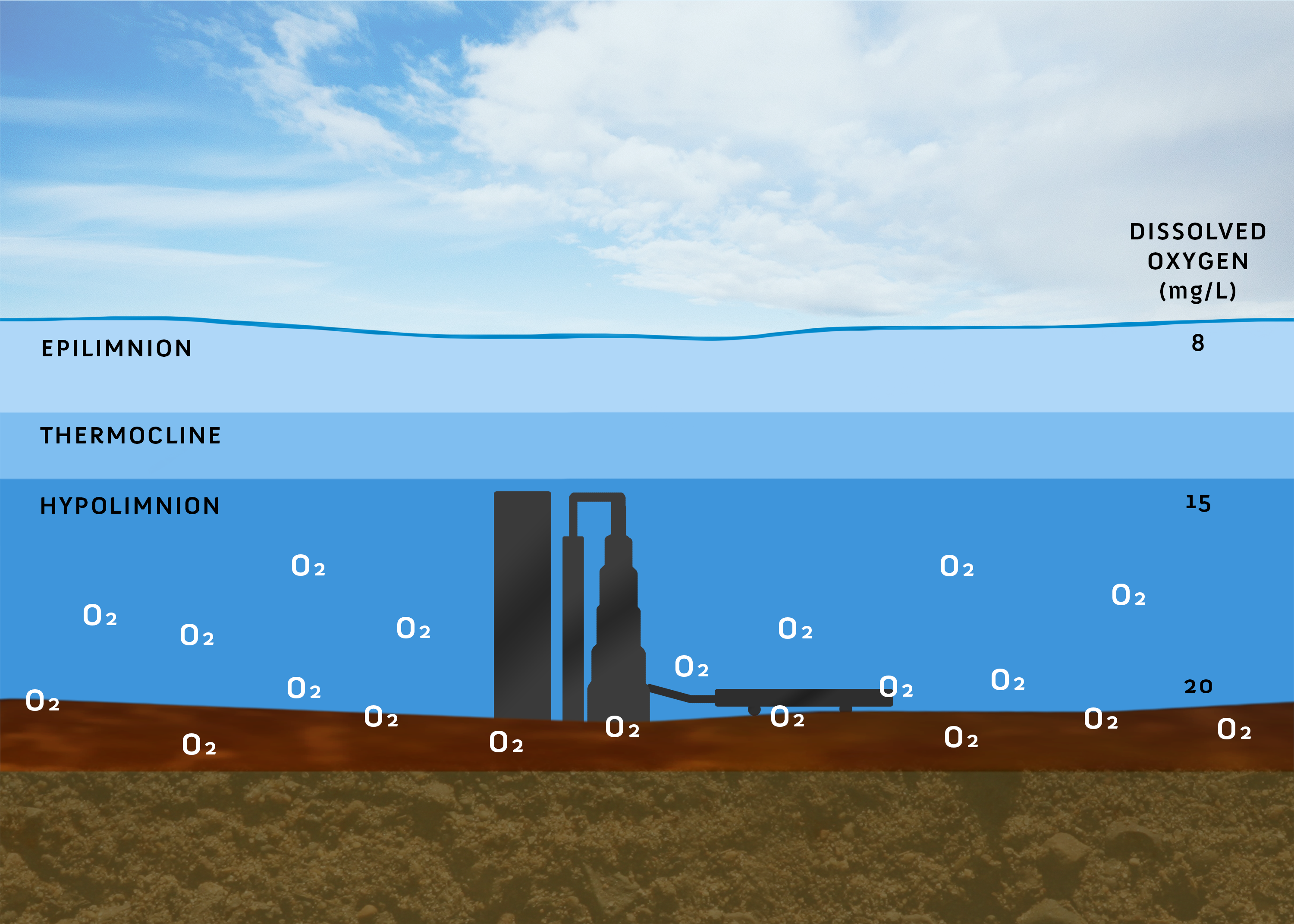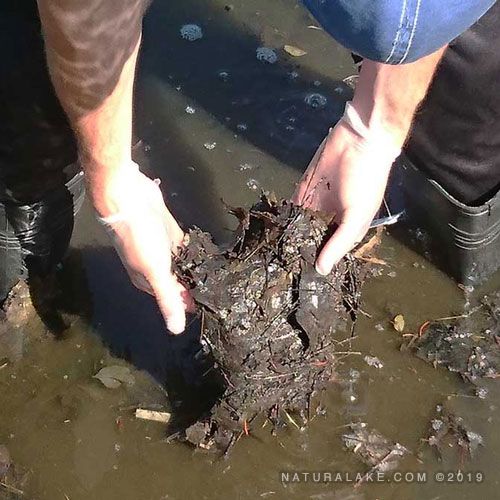
5 Reasons Why Oxygenation Saturation Technology (OST)™ Is the Best Aeration Solution
by Patrick Goodwin
1. More Oxygen. Better Water Quality
OST quantitatively counters oxygen demand by making its own oxygen and dissolving it into the water via gas dissolution chambers. This highly efficient method allows for a precise level of oxygen to be maintained continuously regardless of climate. Traditional aeration techniques which rely on bubbles, water movement, and atmospheric oxygen (only 21%) are limited in the amount of oxygen added to water. This is because wind speed across the surface area of water is the driving force behind how much oxygen is ultimately added, NOT water mixing. As wind speeds drop below 1 mph, oxygen addition is next to zero. This makes for large fluctuations in oxygen levels and subsequent water quality. At best, traditional aeration provides < 40-60% oxygen saturation at temperature on average over 24 hours in the water column, which is far from ideal. Worse is these techniques struggle to maintain 10-20% oxygen saturation over the sediments where most of the water quality issues are coming from in the first place. While 20% oxygen saturation over the sediments is better than zero, imagine the water quality improvement when oxygen saturation is >100% during the dog days of summer. OST blankets the sediments with high levels of oxygen, often set to maintain a constant level of oxygen between 15-20 mg/L directly over the sediments. These levels of oxygen provide exceptional water quality, not achievable with any other system in the market.

2. Does Not Disturb Bottom Sediments or Cause Unnatural Mixing
Traditional air-lift aerators require the bottom waters of a lake to be vigorously mixed upwards to increase oxygen levels in the water. This method of oxygenation poses a variety of water quality risks. Firstly, mixing can re-suspended bottom sediments and prolong the settling times of incoming suspended material reducing overall water clarity. This is especially problematic in lakes with backgrounds soils high in silt and clay or sediments with flocculent organic matter. Secondly, mixing induces sediment oxygen demands making it harder for traditional air-lift aerators to maintain adequate oxygen both in the water column and over the sediments. If oxygen demands aren’t met, mixing can exacerbate water quality issues and stimulate harmful algal blooms (HABs) by way of bringing nutrient-laden bottom water upwards into the photic zone. This has been observed time and time again, and in severe cases leads to full lake fish kills. Lastly, lakes receiving anoxic groundwater, which is often the case when septic systems or developed watersheds are present, will cause worsening water quality conditions from mixing. OST keeps the lake’s natural mixing regime intact, poses no risks, and is, therefore, the technically preferred approach over traditional air-lift aeration.

3. Targets Water Quality Problems at the Source
Accumulated sediments are the primary source of oxygen loss in a lake, called sediment oxygen demand (SOD). Lake Sediments are also the source of many water quality issues including cyanobacteria blooms (called blue-green algae), taste & odor issues, muck accumulation, and heavy metal releases of manganese and iron. Water column oxygen demands (WODs) on the other hand often represent less than 10% of the total oxygen loss in a lake. Surprisingly the most widely used strategy to restore oxygen in lakes, air-lift aerators can only treat WODs by preventing severe oxygen loss in the water column and cannot treat SOD effectively. Even with a full lake aeration system, it will fail to keep the lake de-stratified (defined as less than 0.5°C from surface to bottom) all the time. A thermal gradient of just 0.5°C from surface to bottom is all that is needed to eliminate atmospheric oxygen from getting to the sediments and effectively treat SOD. OST treats lake anoxia at its source by providing high levels of oxygen directly over the sediments eliminating SOD. In fact, SOD declines over time as organics and oxygen debts are burnt off with OST in operation. OST is true lake restoration and will set your lake back in time.
4. Efficiency
It’s all or nothing when using traditional air-lift aeration. All the oxygen must come from the atmosphere, incomplete or partial mixing of a lake can lead to water quality disaster. As mentioned before, not meeting the lake’s oxygen demands coupled with mixing will stimulate HABs every time. To avoid this, the lake’s entire surface area must be mixed vigorously each day in order to expose water to atmospheric oxygen. This is by no means efficient. OST on the other hand treats the area of accumulated sediments, which is much less than the total surface area. Traditional aeration must also be run continuously 24 hours a day, while OST is set to turn OFF or ON depending on in-lake oxygen levels. This automation provides substantial electrical savings. For example, if oxygen drops below 15 mg/L the system turns ON and if oxygen levels go above 20 mg/L the system is turned OFF.
5. No Bubbles
OST is designed to transfer all the oxygen generated or any gas for that matter into water, there are no bubbles. When you see bubbles that means gas is not being transferred and there are design flaws and inefficiencies. For example, nanobubble technology, uses pseudo-science tactics to claim that nanobubbles have the highest gas transfer rates of any system available because of their size. This is not based on reality or science, any bubble no matter the size means gas is NOT being dissolved in water. When you look at the discharge pipe of a nanobubbler you’ll see hundreds of thousands of microbubbles, that’s right microbubbles, not nanobubbles. A nano-sized bubble cannot be seen by the naked eye. All those micro and unseen nanobubbles means oxygen is being wasted to the atmosphere. If treating lakes sediments and improving water quality is your goal any bubbles at discharge will eliminate this from happening. Bubbles induce mixing and reduce the amount of oxygen that can get down into the sediments. Bubbles prevent the development of a sediment oxygen blanket and oxygen penetration downward.


Key Industries for OST
- Agriculture and horticulture
- Aquaculture
- Lakes & Ponds
- Drinking Reservoirs
- Stormwater
Key applications for OST
- Lakes with cool or cold-water fisheries that need both cold water and oxygen
- First-ever Ice preserving oxygenation system
- Lakes with fine sediments (i.e., clay or silt) that, when mixed by traditional aeration, cause turbidity
- Saltwater environments where oxygen transfer is difficult
- Lake areas with filamentous algae issues. OST can get high levels of DO under the mats reducing growth



I need more product info asap how it works any electrical requirements I have a large lake project I’m starting to bid!
OK…I have read the article, but there is really no explanation of “how it works”… looking for how the system functions in order to understand it compared to traditional aeration equipment.
What size of unit is required per acre of lake
I would like a quote for a 3000 gal aquaponics system
Hi Rick,
Thank you for your interest in OST, one of our experts will be reaching out to you.
-Natural Lake Team